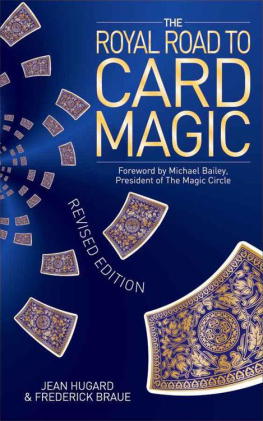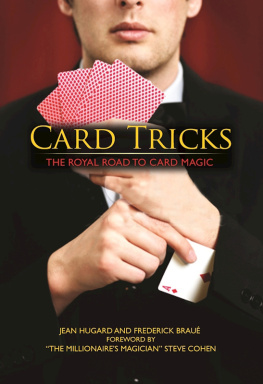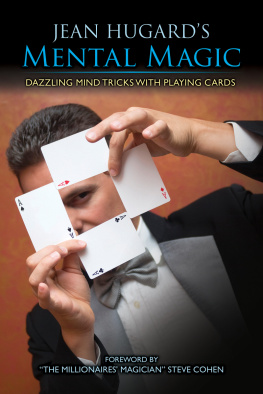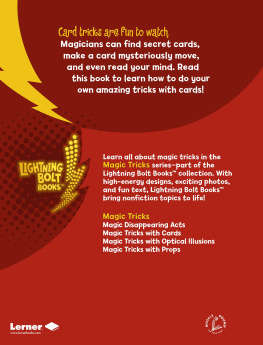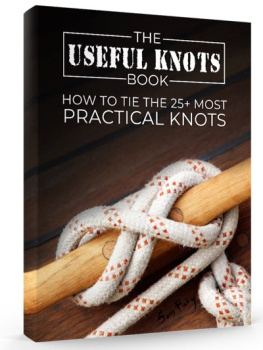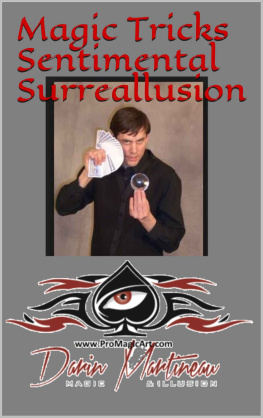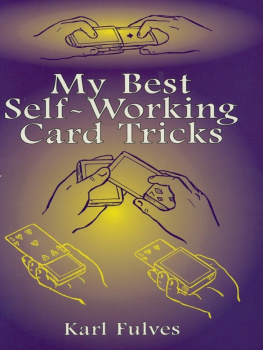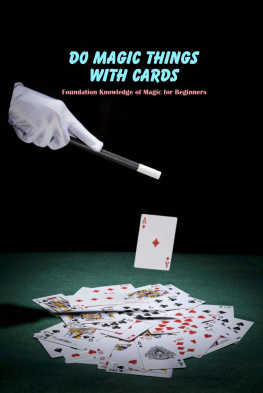
Table of Contents
Foreword
by Michael Bailey
President of The Magic Circle
Even in this era when technological advances are made almost every day and the mysteries of the universe are being unravelled one by one, magic retains its popularity because there is a special kind of fascination in watching a good magician perform a baffling trick. Magic comes in all sizes, but there's little doubt that smaller miracles performed up close are the most appreciated by every age group. And perhaps best of all are those that are presented with something familiar to everyone - a pack of 52 playing cards.
The renowned lending and reference libraries at The Magic Circle Headquarters in London house over 8,000 volumes on the art of magic. The libraries are very popular with members who consider that learning from books is still, in this electronic age, the best way of improving their skills in magic. If I were asked to recommend just one tome from that vast collection it would be The Royal Road to Card Magic. It was the first magic book I devoured when I started out as a young conjuror, and I have treasured it ever since.
Authors Jean Hugard and Frederick Braue were masters at card magic and respected teachers of their craft. They combined their extensive knowledge to produce this comprehensive manual that guides the beginner through the basic sleights necessary to perform a variety of baffling card tricks. Many of these are easy to accomplish after the necessary practice, and some are self-working and need no dexterity at all.
This new edition with its updated design and clear illustrations is very easy to read, and if the text and instructions are carefully followed, and enough rehearsal given, there is no doubt that the reader will be able to perform little miracles. But knowing the method is only the beginning. The secrets in this book are far too good to reveal other than to fellow magicians, but only half the fun of watching magic is to try to puzzle out how it's done. The other half is to enjoy the personality of the magician who is fooling you. The authors rightly emphasise that it is not so much what you do but how you do it that is important. Also that entertainment value, meaning the blending of carefully thought out, interesting patter with good routining, is the vital ingredient to becoming a magician who will not only amaze but also enchant with skills in presentation. And all this with just a borrowed pack of cards.
The great British magician David Devant always advised his pupils to learn one trick at a time. Only when you've mastered one should you proceed to the next. He knew that it's better to know a few tricks really well than a whole lot sparsely. Devant also said that there is no short cut to success as a performer, but that the road by which all magicians need to travel is a very pleasant one. I would agree, and simply add that the shortest and easiest route to reach the destination of successful card magic is a careful study of this indispensable book.
Preface
Many years ago, the great English conjurer David Devant was approached by an acquaintance new to sleight of hand with cards. 'Mr Devant,' said this young man, 'I know 300 tricks with cards. How many do you know?' Devant glanced at the youth quizzically. 'I should say,' the magician responded dryly, 'that I know about eight.'
Devant was making a point with which all professional magicians are familiar. To perform card tricks entertainingly you must not only know how the tricks are done, but also how to do them. There is a vast difference between the two, and if proof were needed one need only watch the same feat performed by a novice and by an expert card conjurer. The novice knows the mechanics of so many tricks that he or she cannot do any one feat really well; the professional performs a smaller number of tricks, which he or she knows how to present in such a way as to create the greatest possible impression upon those who watch.
We cannot emphasise too strongly that knowing the secret of a trick is not the same as knowing how to perform that trick; and that knowing the secret of hundreds of tricks is of little value unless each can be performed smoothly and entertainingly. It is far better to know only a few tricks that can be performed with grace, skill and effect.
In writing this book, we have attempted to teach you card tricks that may be performed anywhere, at any time, under any circumstances, for any company and using any pack of cards. You will not need 'trick' packs of cards, nor special cards, nor expensive accessories. This is most important, because it means that no matter where you may be you need only borrow a deck of cards when called upon to entertain; the ability to amuse and interest will be literally at your fingertips.
To ensure that you will be a good card magician, we have introduced you to the mysteries of card magic progressively. Each chapter describes a new sleight or principle and a selection of tricks follows in which only that particular sleight and those already learned are used. We do not suggest that all the tricks in each section should be mastered before you pass on to the next sleight. You should, however, select at least two and learn them so well that you can perform them smoothly and entertainingly before going any further. These tricks have been chosen with the greatest care and every one of them is effective if properly done. If you find that, in your hands, a certain trick falls flat, this undoubtedly means that further study is required.
Clearly, to travel the royal road to card magic, you must begin with the fundamental principles and learn these well, as you would in learning any other art. Fortunately, the study of card conjuring is a delightful task and one that is no less fascinating than the performance itself. For this reason, we have found that the student is inclined to race ahead to explore the distant pastures that he or she is sure (and rightly!) are lushly green. We cannot blame you if you, too, wish to rush through this book, but we would rather have you emulate the tortoise than the hare. By making haste slowly, by really learning what is given you in one chapter before proceeding to the next, you will, in the end, be a far better card magician.
By adhering to our plan of study, you will not only learn practical sleights and subtleties, but you will also simultaneously add to your repertoire of good card tricks that will surprise and please all of those who see them. Best of all, you can begin performing tricks of sleight of hand as soon as you have mastered the first chapter, and thus at once learn through practical experience before audiences how tricks must be presented to achieve the greatest effect from them. Then, too, we have inserted in each chapter feats that are self-working - effects that require no skill on the part of the performer. These will give you an opportunity for concentrating your whole attention on acting your part in such a way as to bring out the trick's greatest possible effect.
We reiterate that there is a vast difference between doing and performing card tricks. Since your primary purpose in performing sleight of hand with cards is to entertain those who watch, it is not enough that you should achieve technical perfection alone. You must also make your tricks amusing and interesting by weaving about a trick's basal plot a pleasant discourse that will divert the spectators. We have tried to show you how this is done by outlining talk, or patter, for most of the tricks. Naturally, your patter should be in keeping with your own character: cheerful and amusing if you have an ebullient personality, more straightforward if you are a serious person. For this reason you should use the patter we have suggested only as an illustration of how the bare bones of a trick may be clothed in talk and action to make the
Next page
